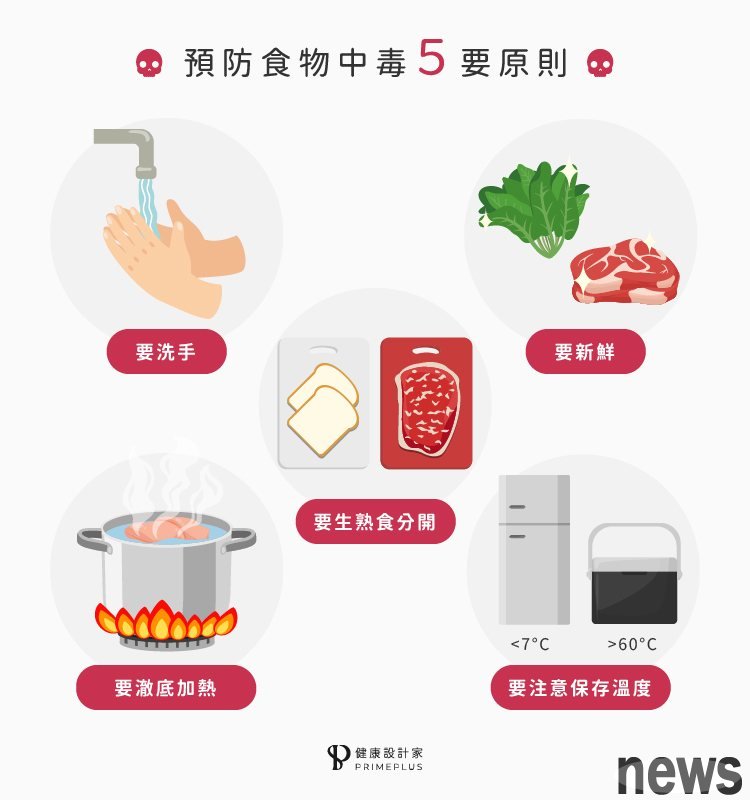
Recent news reports that ice shop products have caused dozens of people to suffer from abdominal pain, abdominal pain, and even severe food poisoning symptoms such as bloody stools, kidney failure, etc. Their products have tested a variety of pathogenic bacteria that are harmful to humans, such as Salmonella, Staphylococcus aureus, and Cactus. Such news is undoubtedly a shocking news for people who like bowls of ice on the hot summer days. How to prevent these harmful bacteria from contaminating food is a topic that every family, restaurant practitioner and people who eat it must know. Next, we will let [PrimePlus Health Designer] brand nutritionist Sean introduces three common pathogenic bacteria, such as Sandian, Staphylococcus aureus and Cactus, and we also share with you the effective way to eliminate the disease!
Three common pathogenic bacteria. Salmonella enterica is the most relevant pathogenic bacteria to "egg"! It is usually caused by chicken contamination outside the egg shell and often appears in inappropriately preserved chicken eggs, raw egg liquid, and cakes. Sandella preference grows in the temperature of about 35-37°C, so in this hot and hot summer day, how to preserve food has become a big test. However, Sandella is not heat-resistant and can be killed by sufficient heating.
If you eat foods stained by Samenella, symptoms may occur within 4-48 hours. Typical symptoms include abdominal pain, abdominal pain, inflammation, vomiting, etc. with blood or mucus. If you take the medicine as soon as possible and deal with it properly, the symptoms will gradually improve in about 2-3 days.
. Staphylococcus aureus, Staphylococcus aureus, is often found in our skin, hair and stools, especially the wounds of the melted swelling. Therefore, Staphylococcus aureus is very prone to infect food after contacting food through human body. What is more special is that Staphylococcus aureus is different from other pathogenic bacteria and is not easily removed through simple heating. Therefore, special attention should be paid to the fact that if there is a wound or a sluggish body, it is necessary to properly wrap the wound and stop food preparation and treatment. At the same time, you should also pay attention to the cleaning of the utensils in order to effectively prevent the invasion of Staphylococcus aureus.
If you eat foods infected by Staphylococcus aureus, you may experience unsuitable symptoms within 1-7 hours, with the main symptoms being severe vomiting, disgust, and poor appetite. Symptoms usually recover slowly after several days. During this period, you need to pay attention to the supplement of moisture and electrolytic quality to avoid irrigation. If necessary, antibiotics can be taken under the guidance of professional medical staff.
. Cactus characteristics: Bacillus cereus (Bacillus cereus), it often appears in inappropriate grains or powders. For example, if cooked or fried rice is left at room temperature for too long, it is likely to be infected with this bacteria; it can also be found in soy sauce, desserts, and milk products, so it is a very common pathogenic bacteria. It likes to grow in a temperature of about 30°C, so the summer environment needs to pay more attention to the preservation of food! However, this bacteria is not heat-resistant. As long as the food is fully heated, it can kill potential bacteria.
If you eat food contaminated by cactus, the symptoms can be roughly divided into two types: mainly vomiting or abdominal cramps. Under proper care, the symptoms will slowly recover after about 1-2 days. During the same period, don’t forget to replenish moisture and electrolytic quality.
【PrimePlus Primary School Planning Highlights】5 Principles for Preventing Food Poisoning
After reading the introduction of the above three common pathogenic bacteria, Sean will learn with you how to effectively prevent food poisoning caused by these bacteria. It can be summarized into a "five principles", which are:
1. To wash hands, there has been a study that even more bacteria on the hands are than those on the bush! Therefore, in order to ensure food safety, before cooking and eating food, you should wash your hands thoroughly to reduce the risk of food being stained by hand.
2. When choosing ingredients fresh, pay attention to the freshness of the ingredients. The fresher the ingredients, the lower the chance and degree of contamination of pathogenic bacteria.
3. To separate raw and cooked foods. This is the most common thing that many families or restaurants ignore. Use the same kitchen knife or cutting board to process raw and cooked food. This can easily cause cooked foods to be stained with bacteria contained in raw foods, increasing the suspicion of food poisoning. The correct way to do this is to use different instruments separately when handling raw and cooked food to effectively avoid cross-contamination.
4. The bacteria that will cause food poisoning are mostly not tolerant and can be killed by high-temperature heating. Therefore, when preparing, it is advisable to heat up the food fully until the center temperature reaches 75° then eat it before eating, and at the same time, as well as reduce the chance of raw food as much as possible.
5. Pay attention to the storage temperature. Many food problems are caused by incorrect storage. Usually bacteria can grow rapidly in the temperature of 7-60°C, causing food spoilage, which is also what scientists call "dangerous temperature belt". Therefore, in order to effectively avoid the large growth of bacteria, when storing food, we must avoid dangerous temperature belts. For example, the refrigeration temperature should be less than 7° C. The room temperature should not be placed for too long, the temperature of the temperature box should be higher than 60° C… etc. are all management made to control the storage temperature..

News cases of food poisoning always occur from time to time and often cause considerable upsets. It is difficult to make people feel "nothing is safe". But in fact, as long as you remember the above five principles, you can significantly reduce the risk of food poisoning. However, these knowledge is not the patent of a restaurant or chef, but the skills that everyone should have! Only by having the right knowledge can you protect your own and your family’s health. After all, the health and non-life are like 1 and 0 in multiplication. Only with the cornerstone of health can one have the ability to move towards one's goals and ideals!
Fa Xinding: If you find a suspected symptoms of food poisoning, please immediately accept treatment from professional medical personnel. Do not delay medical treatment because of the mild symptoms.
